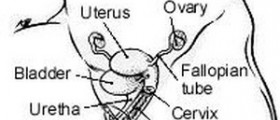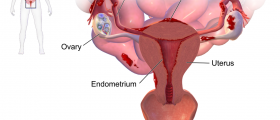
Endometriosis is a condition which manifests through cells normally found in the lining of your womb growing somewhere outside the uterus. Most commonly, these growths appear on the ovaries, fallopian tubes and tissues around the womb. However, the growths may appear on many organs in the body like vagina, bladder, bowel, lungs or brain, even though these cases are extremely rare.
Additional Information on Endometriosis
Before every woman has her period, the lining on her uterus wall becomes thicker in order to receive the fertilized egg. If the woman does not get pregnant, this thickened part gets expelled along with the blood during the menstruation. If endometrial tissue migrates to some other parts of your body, it will also get thick, but it will not leave the body and instead remain localized in the affected area. The presence of such tissue triggers pain, swelling and scarring. So, if this tissue is found in your fallopian tubes, endometriosis may lead to infertility.
This condition is quite common in women, with 22 of each 100 individuals suffering from it. The risk groups are women who are older than 30 but younger than 40. However, it may also affect women younger than 20, even though these cases are not so common.
Symptoms and Signs of Endometriosis
Some of the main symptoms of this condition are pain during or after sexual intercourse, irregular or heavy bleeding periods, painful bowel movements and extreme fatigue. The problems with bowel movement take place once the lower abdomen swells. Thus, urinating blood or finding blood in your feces can be signs of endometriosis affecting your bladder or bowel. Either way, endometriosis is bound to disappear with the onset of menopause.
However, before this happens, endometriosis may result in bleeding and formation of scar tissue. Also, it may trigger infertility, miscarriages or premature births, cysts and constipation or increase the risk of suffering from cancer, predominantly affecting ovaries.
Treatment for Endometriosis
After performing the necessary tests and diagnostic screenings, your doctor may recommend you to visit a specialist like a gynecologist. In order to complete the diagnosis for this condition, you will need to undergo a small-scale surgery called laparoscopy, when samples of the abnormal growths will be taken and observed.
Then, once you have been diagnosed with this condition, your doctor may prescribe medications or suggest certain lifestyle changes in order to help you deal with endometriosis.
Surgery for Endometriosis
Surgery may also be a necessity in some cases, especially when endometriosis is affecting your fertility, being present in the womb or the ovaries.
Possible surgical approaches for this condition may involve removal of abnormal growths by cutting them off, destroying them with laser heat or removing them with helium gas exposure. Once the surgery is complete, endometriosis may return. However, doctors will prescribe medications which will keep the condition at bay and monitor endometriosis with ultrasound or X-ray scanning.

















Your thoughts on this
Loading...